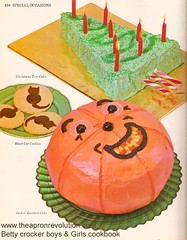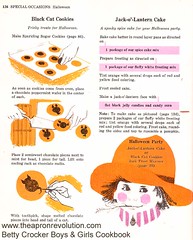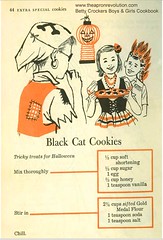 I am hosting a Halloween cocktail party this evening. We will have cocktail punch, finger foods and nibbles. It is, of course, a fancy dress or costume party. Hubby and I are going as “The Spirit of Jazz”. I will try to get at least one photograph of us and other guests.
I am hosting a Halloween cocktail party this evening. We will have cocktail punch, finger foods and nibbles. It is, of course, a fancy dress or costume party. Hubby and I are going as “The Spirit of Jazz”. I will try to get at least one photograph of us and other guests.
I thought I would share these fun vintage Halloween treats from the Betty Crocker Boys n Girls cookbook. The Fun pumpkin Cake up top is so simple yet so fun.
 Here are the instructions for the Jack-O-lantern Cake. And some simply ‘Black Cat Cookies’.
Here are the instructions for the Jack-O-lantern Cake. And some simply ‘Black Cat Cookies’. 






“Throughout Ireland and Britain, there is a long tradition of carving lanterns from vegetables, particularly the turnip, mangelwurzel, or rutabaga. The turnip has traditionally been used in Ireland and Scotland at Halloween, but immigrants to North America used the larger native pumpkin, which are both readily available and much larger – making them easier to carve than turnips.
While turnips have always been used in Ireland, lanterns in Scotland were originally fashioned from the thick stem of a cabbage plant, and were called "kail-runt torches". It was not until 1837 that jack-o'-lantern appeared as a term for a carved vegetable lantern, and the carved pumpkin lantern association with Halloween is recorded in 1866.
In the United States, the carved pumpkin was first associated with the harvest season in general, long before it became an emblem of Halloween. In 1900, an article on Thanksgiving entertaining recommended a lit jack-o'-lantern as part of the festivities. The poet John Greenleaf Whittier, who was born in 1807, wrote "The Pumpkin" (1850):
“Oh!—fruit loved of boyhood!—the old days recalling,When wood-grapes were purpling and brown nuts were falling!
When wild, ugly faces we carved in its skin,
Glaring out through the dark with a candle within!”
The carved vegetable man has many variations to its story. He is often referred to as ‘Jack’. An Irish tale tells that Jack (usually a smart farmer or land worker) tricked the Devil into climbing an apple tree, and once he was up there Jack quickly placed crosses around the trunk or carved a cross into the bark, so that the Devil couldn't get down.
“Another version of the story says that Jack was getting chased by some villagers from whom he had stolen, when he met the Devil, who claimed it was time for him to die. However, the thief stalled his death by tempting the Devil with a chance to bedevil the church-going villagers chasing him. Jack told the Devil to turn into a coin with which he would pay for the stolen goods (the Devil could take on any shape he wanted); later, when the coin/Devil disappeared, the Christian villagers would fight over who had stolen it. The Devil agreed to this plan. He turned himself into a silver coin and jumped into Jack's wallet, only to find himself next to a cross Jack had also picked up in the village. Jack had closed the wallet tight, and the cross stripped the Devil of his powers; and so he was trapped.”
“The term jack-o'-lantern originally meant a night watchman, or man with a lantern, with the earliest known use in the 1660s in East Anglia; and later, meaning an ignis fatuus or will-o'-the-wisp. In Newfoundland and Labrador, both names "Jacky Lantern" and "Jack the Lantern" refer to the will-o'-the-wisp concept rather than the pumpkin carving aspect.”
Any way you slice it ( pun intended), late season vegetables played a major role in the lives of early people. Often with the idea of chasing away bad or celebrating good harvest.
I hope you have fun carving your pumpkins or setting up your own Vegetable Man. Halloween is a fun time to dress up, celebrate friends and eat far too many treats.
Happy Homemaking.


Thanks for this post. You made me smile. The Betty Crocker Boys and Girls Cookbook was my first cookbook. I haven't thought about it for ages...... but I bet I still have it somewhere.
ReplyDeleteThanks for the memories!
that turnip is creepy!
ReplyDeleteI just finally posted my halloween post...and just realized i titled it the same as this! :) good times.